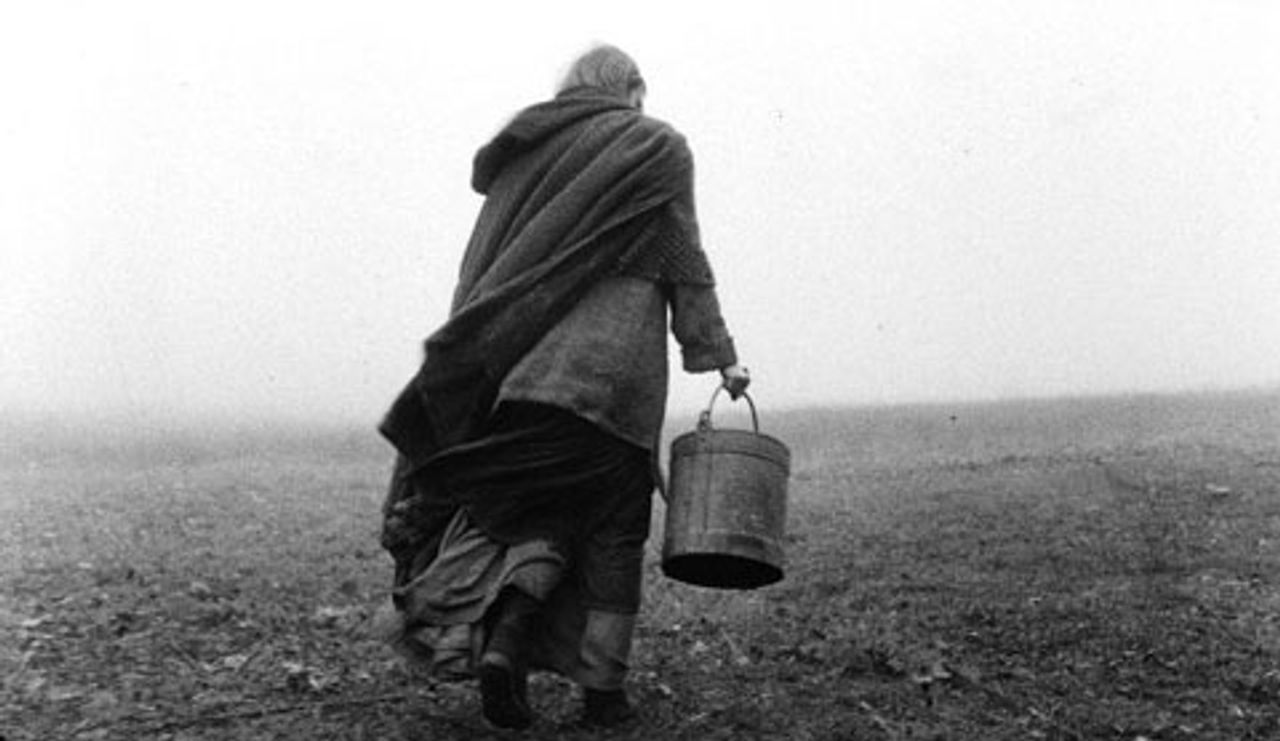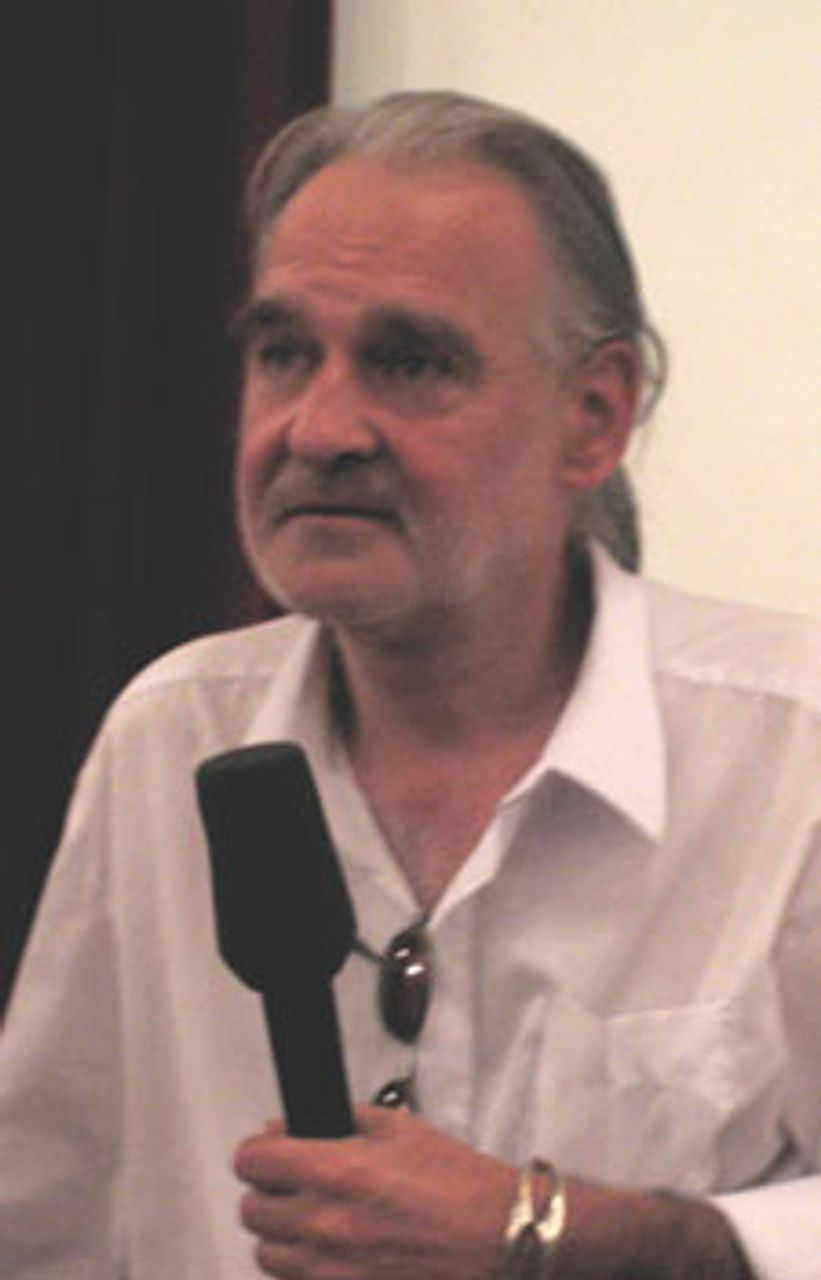This is the second in a series of articles on the recent Berlin film festival, the Berlinale, held February 10-20, 2011.
The competition section of the 2011 Berlin International Film Festival was numerically thin by recent standards (just 16 films in the official section), due apparently to the decreased number of movies being funded in the wake of the 2008 financial crash.
 The Turin Horse
The Turin HorseOne entry in the competition eagerly awaited by media critics was the latest film from the veteran Hungarian director, Béla Tarr (born 1955), The Turin Horse. Tarr has been making films for over 30 years. He commenced his career with movies dealing with social life in Hungarian society shot in almost documentary fashion. Over time he gained a reputation as a nonconformist with a critical view of Hungarian society. One of his earlier films is titled The Outsider.
 Béla Tarr
Béla TarrIn interviews Tarr has declared that the main task of his films is to “understand social reality”. He is also on record criticizing the current right-wing Hungarian government, which he asserted “despises intellectuals because they’re liberal and oppositional”.
In an interview given in 2001, Tarr was also dismissive of the mainstream film industry: “We do not knock on the door of the film industry … rather it is a question of kicking it down in order to show faces and show what life is”. He went on to explain that he had established his own criteria for making film that allowed him to maintain a degree of independence, i.e., making low-budget films using a largely non-professional crew. His aim, he stressed in 2001, was “to deal with social problems which are just not of a social nature, but increasingly take the form of ontological and cosmic problems”.
Tarr is probably best known for his seven-hour epic Sátántangó (1994) and his 2000 film Werckmeister Harmonies. Tarr claims there is a continuity to his work, but in fact Werckmeister Harmonies is far removed from the realist films of his youthful period. Formal cinematic elements move increasingly into the foreground. Tarr has said that the most important single ingredient in his films is music and that he can commence the film only when the score is written.
Werckmeister Harmonies consists of a series of long, very carefully orchestrated shots, some of which help the story along, while others merely depict the film’s central character in close-up as he plods grimly along a muddy track. The music, initially compelling, becomes increasingly irritating with repetition.
The plot of the film involves the threat to social stability presented by the arrival in a small town of a circus featuring sensational attractions, including a demagogue known as the Prince able to incite the masses into rebellion. The citizens in the town appear in the film largely as stoic, wordless individuals assembled in the town square waiting for something to happen. Tarr establishes a brooding, threatening atmosphere that eventually explodes into violence. In the only scene where they do move into concerted action, the town’s workers are a threatening force, marching in unison to destroy a public building and intimidate its inhabitants.
Tarr’s film at the 61st Berlinale, The Turin Horse, adopts many of the formalist elements of Werckmeister Harmonies, only to strip them down into an even more minimalist form. The animal referred to in the title is the horse embraced by the German philosopher Friedrich Nietzsche in a Turin public square in 1889. Nietzsche had intervened to prevent the driver of a hansom cab whipping the horse. Following his efforts to save the animal, Nietzsche fell into a dementia that was to plague him for the next decade until his death.
Tarr, on his own admission a great admirer of Nietzsche and his philosophy, prefers to speculate on the fate of the horse. The two-and-a-half-hour film is shot in black and white, with virtually no dialogue and consists of just 30 takes, dealing largely with the cab driver and his daughter going about their daily business over the course of six days. Premonitions of imminent catastrophe abound. Winds howl, the horse refuses to leave his stall, a visitor predicts the end of the world, the well on the grounds of the house where the driver lives with his daughter dries up.
In his notes for The Turin Horse Tarr comments that life for the cabman and his daughter “is very meager ... and infinitely monotonous. Their practiced movements and the changes in seasons and times of day dictate the rhythm and routine which is cruelly inflicted on them. The film portrays mortality, with that deep pain which we, who are under sentence of death, all feel”.
Tarr is able to generate some compelling images in his films. His imaginative and painstakingly crafted setting of scenes devoted to the small change of everyday life indicates the enormous potential of cinema to do far more than passively record events in a realist manner. In Tarr’s more recent films, however, the allure quickly wears off. In the course of his career it is evident that the social component in his films has been increasingly eclipsed and replaced by what Tarr regards as larger ontological or cosmic questions.
Despite Tarr’s claims that he seeks to reveal or portray social reality, one, in fact, learns nothing of substance about social life or relations either in the Turin of the 19th century or, by analogy, in contemporary Hungary. Instead we are left with quasi-religious images of the cabman’s daughter tending her father, the cosmic struggle of man against an unremitting nature and the trite recognition, common to forms of existentialist thinking, that the good life requires continual contemplation of the imminence of death.
By his admirers Tarr has been compared to the Russian filmmakers Andrei Tarkovsky and Aleksandr Sokurov, and the Greek filmmaker Theo Angelopoulos. In my opinion, there is some validity in the comparison. Their itineraries speak to the dilemma of the self-made intellectual with a social conscience who has been overwhelmed by the complexities of social development in the second half of the 20th century, in particular the betrayal of socialist ideals by Stalinism. Disillusioned with mankind and unable to find their social and historical bearings they all retreated, at least in their later work, into near-messianic forms of pessimism.
In his Revolution Betrayed, Leon Trotsky, the master in illuminating social relations based on a concrete materialist analysis, challenged a world-view which concentrates exclusively on cosmic challenges. Stressing that the Marxist world-view sets out from the development of technique as the fundamental spring of progress, Trotsky writes: “If you conceive that some cosmic catastrophe is going to destroy our planet in the fairly near future, then you must, of course, reject the communist perspective along with much else. Except for this as yet problematic danger, however, there is not the slightest scientific ground for setting any limit in advance to our technical productive and cultural possibilities. Marxism is saturated with the optimism of progress, and that alone, by the way, makes it irreconcilably opposed to religion”.
For Béla Tarr, on the contrary, the limitations of humanity opens up merely an infinite number of dead ends. As a result, the afterlife presents itself as an increasingly attractive prospect.
To be continued
The author also recommends:
The legacy of the 1960s: films by Fernando Solanas and Theo Angelopoulos
[26 February 2004]
Aesthetic choices: Aleksandr Sokurov’s The Sun
[20 November 2009]
